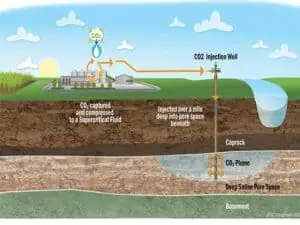

SCS Engineers Staff Scientist Patty Herman takes readers through Carbon Capture Storage and Sequestration basics for newcomers to the industry and the public. Carbon dioxide (CO2) capture and sequestration (CCS) is a set of technologies that can greatly reduce CO2 emissions from new and existing coal- and gas-fired power plants and large industrial sources. [USEPA-Climate Change]

The carbon capture and sequestration process is a multifaceted approach to mitigating climate change and involves various techniques and strategies. Continued research, innovation, and investment in CCS are essential to address global greenhouse gas emissions challenges effectively, but CCS: A Primer is a great place to start. Please feel free to share this and all SCS Engineers’ educational resources.
The Underground Injection CCS Team develops educational videos and blogs to share with clients and for public edification. If you or your clients want to learn about Carbon Capture and Sequestration and the incentives associated with reducing carbon emissions, please visit our Video Learning Library: Clean Air and GHG Reduction.
Additional Resources
Unlocking Net Zero Emissions in the California Delta The picturesque California Delta, often referred to as the Sacramento-San Joaquin Delta, is emerging as a geological sweet …
How Seismic Reflection is Innovating Carbon Sequestration Methods Commercial Carbon Capture and Sequestration in the US The US is home to the largest number of commercial carbon capture and sequestration (CCS) projects worldwide, with approximately 50 new …
Flow Modeling for CO2 Storage Efficiency In her paper, Utilizing Multiphase Flow Modeling to Estimate CO2 Solution Storage Efficiency and Sequestration Project Size, author Kacey Garber discusses how developing an understanding of CO2 storage efficiency and CO2 …
Protect Aquifers During Carbon Sequestration Many companies are exploring carbon capture and sequestration (CCS) to help reach greenhouse gas emission reduction goals. Protecting aquifers is a primary concern for the public to safeguard underground drinking …
About the Author
 Patty Herman graduated from Southern Illinois University Edwardsville with a Master of Science in Biological Sciences. Working in diverse and unique habitats enhances her awareness of the ecosystem’s fragility and the need to protect it, especially for agencies during the permitting process. During graduate school, she was selected by the Illinois Department of Natural Resources for the Natural Heritage Residency program. The residency provided exposure to resource management in both public and private sectors, interacting with many federal, state, and local agencies, as well as NGOs and landowners. She writes and executes management plans and permits using her intensive experience in land management techniques. She has the unique ability to find common ground with stakeholders, agencies, and the public in safe land management for industrial and manufacturing. Contact Ms. Herman at or LinkedIn.
Patty Herman graduated from Southern Illinois University Edwardsville with a Master of Science in Biological Sciences. Working in diverse and unique habitats enhances her awareness of the ecosystem’s fragility and the need to protect it, especially for agencies during the permitting process. During graduate school, she was selected by the Illinois Department of Natural Resources for the Natural Heritage Residency program. The residency provided exposure to resource management in both public and private sectors, interacting with many federal, state, and local agencies, as well as NGOs and landowners. She writes and executes management plans and permits using her intensive experience in land management techniques. She has the unique ability to find common ground with stakeholders, agencies, and the public in safe land management for industrial and manufacturing. Contact Ms. Herman at or LinkedIn.